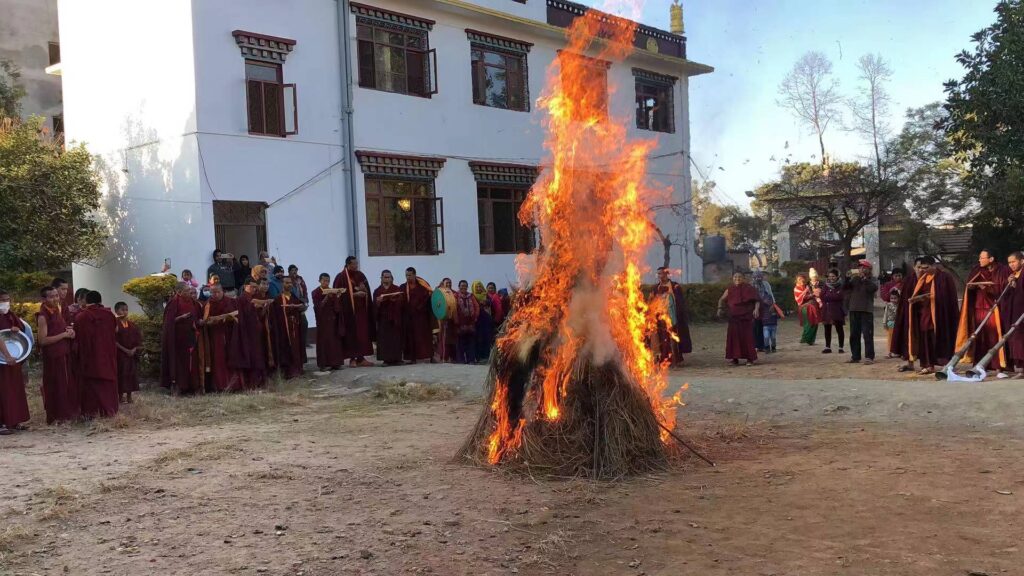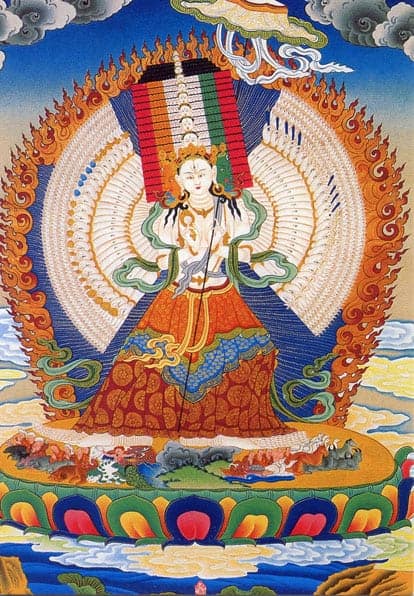Sitatapatra is a female deity whose power and “magical formulas” originated from the crown protuberance (ushnisha) of Buddha Shakyamuni while he remained in samadhi in the Heaven of the Thirty-three. Sitatapatra’s name means “white umbrella” (Tib. Dukkar), and it is the main emblem that she holds with her left middle hand. She is brilliantly white in color and full of love and compassion. She is depicted with 1,000 heads, 1,000 arms, 1,000 legs, and a trillion eyes. She holds a variety of weapons, and with her central hands, she holds a dharma wheel and the handle of the white parasol.
The practice related to this deity is found both in the sutra and mantra traditions, and it is considered a powerful method to avert obstacles. Sitatapatra is therefore invoked to protect practitioners against calamities and malignant beings. Reciting her mantra averts evil influences and purifies defilements. Her powerful dharani protects one when worn in an amulet. Additionally, the dharani has the power to alter the weather and gives immediate protection in adverse circumstances. The practice of Sitatapatra contains many rituals such as fire offering, torma offering, drawing mandalas, and establishing protective circles. Her dharanis are often inserted as dharma relics into stupas.
Sitatapatra Puja: Removing Obstacles
Every year, a three-day Sitatapatra puja is performed at Do-Ngak Ling Monastery. On the first day of the puja, the ritual master sets the mandala with the required tormas and offerings. The main torma represents Sitatapatra, her retinue, and palace. This is a white torma with colorful adornments and Sitatapatra’s image on the top. The outer offerings are the same as those usually set for a peaceful deity. But since the practice is meant to avert obstacles, another table is placed right beside the mandala with a fierce-looking torma and a set of offerings for the wrathful deities. The mantra and dharani is recited with loud and strong voices, and the drums and trumpets are played fast and intensely. The second torma is used as the receptacle for the invoked obstacles, and on the last day of the puja, it is burned.

Blessed Sitātapatrā Born from Tathāgata’s Uṣṇīṣa, Vajroṣṇīṣā, Great Dispeller, great goddess with a thousand arms, great goddess with a thousand heads, great goddess with a trillion eyes and indestructible blazing characteristics, Great Exalted Vajra Goddess, bring about well being for us and all sentient beings within the maṇḍala of the three planes of existence!
Excerpt from The Noble Dhāraṇī of The Supreme Accomplishment of Sitātapatrā Born from the Tathāgata’s Uṣṇīṣa, the Great Invincible Dispeller, translated by Samye Translations.


